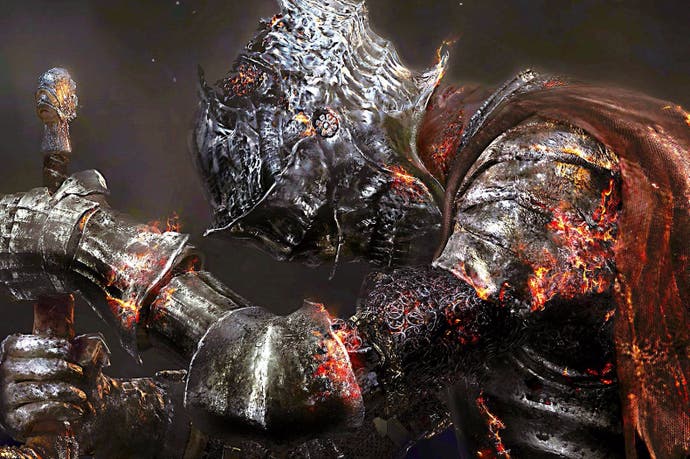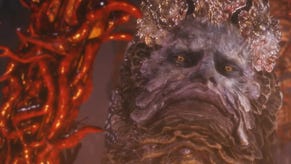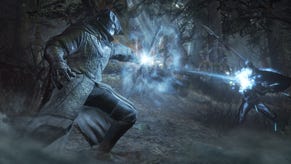Digital Foundry: Hands-on with Dark Souls 3
Early PS4 impressions, and how From Software's next epic compares to Bloodborne.
Running on PS4 for its network stress test, From Software offers a remarkable taster of what's to come in Dark Souls 3, six months ahead of its 2016 launch. The engine at its heart already has many parallels with Bloodborne, a PS4 title that blazed a trail just this year with the studio's more experimental ideas. Both in its nightmare-fuelled art design and its technical frontiers, Bloodborne was a marvel to behold - a current-gen title in the Souls mould, and also indicative of the direction taken with the upcoming multi-platform Dark Souls 3.
With our hands on this early code, we see certain technical points are - perhaps inevitably - re-introduced from the Sony exclusive. Needless to say, Bloodborne pushed ahead of what we saw in Dark Souls 2, even compared to the 1080p Scholar of the First Sin remaster. Its new lighting model took centre-stage, bringing detailed specular mapping across Yharnam. Materials were lit with more accuracy - from the flapping cloaks to the cobblestone floors, giving the town a wet sheen where particle effects lit each surface. It set a precedent, a divide between the simpler lighting and world designs on From Software's last-gen titles and the studio's output on PS4 and Xbox One.
Based on this demo across the High Wall of Lothric, Dark Souls 3's engine matches Bloodborne on many points. Lighting is a similar plus point based on this demo, and it runs at a full 1920x1080 native resolution on PS4 as well. As for anti-aliasing, we're in familiar post-process AA territory again; pixel crawl is similar to From Software's last game, and on most sharp geometric edges it's ineffective. Fine details like plants produce visual noise in this stress-test, especially as we pan the camera, but at the very least its base 1080p image looks crisp.
As for lighting, Lothric is a broad kingdom expanse, and exposed to more sunlight than anything in Yharnam's early areas. Its a complete change in art style, but the method of lighting and character shadows still show a commonality. Armour and leather cloaks diffuse light based on their material, light shafts stream between mossy castle arches, and shadows cast dynamically from objects - a method similar to From Software's last work. It's clear the engine gives its artists scope to achieve gorgeous backdrops, even with a 'castle and knight' theme in mind. Dark Souls 3 is using the technology to great effect so far, though perhaps in a different way to Bloodborne.
As for enemies, Dark Souls 3 pushes the engine in a different direction. We can expect the horizon to broaden somewhat with the full game, but Lothric is filled with smaller clusters of undead knights and mages - using nothing like the fur shaders of Bloodborne's townsfolk and beasts. On the other hand, each turret on the wall is occupied by a wyvern. It's a staple of Dark Souls, giving us a huge, beautifully detailed presence that fills the area with transparency effects when walking close. It's a difference in the way Dark Souls 3 pushes the hardware - a test of new proportions compared to From Software's other recent work. And of course, we're only touching on the surface of what the final game might bring in later areas.
In battle, transparency effects like fire, and even heavy splatters of blood transfer straight from Bloodborne at full resolution. There's no paring back on the quality here, and particle effects in particular look superb when swords clash with shields and masonry. Crashing through objects too - using the Havok physics engine - also creates huge billows of dust, and this effect in particular stands out compared to earlier the weaker puffs of earlier Souls games.
But something is missing thus far in this early build. From Software uses the YEBIS 3 middleware in its previous games, a post-processing suite that adds depth of field, motion blur, and other filters like chromatic aberration. Notably in Dark Souls 3, we're missing motion blur entirely. It's an effect that even made it into last-gen versions of Dark Souls 2, where a per-object sampling was used on slashing weapons. Instead all we have in this early build is a simple colour trailing behind.
It's a strange cut, and we're curious to see if it'll be reinstated for the final build - we're hopeful here as the effect was fully present and correct in Bloodborne. On the plus side, we keep its depth of field effect, though chromatic aberration is also absent right now. This filter distorted the image in Bloodborne, producing an effect similar to an old camera lens - a stylistic flourish that made sense in the context of its Gothic art style. However, it was also pretty heavy-handed in its use, producing a rainbow pattern on high contrast edges that exaggerated its aliasing. It isn't to everyone's tastes, and Dark Souls fans might be relieved to hear that's gone - but whether we get motion blur back remains to be seen.
Another big point in Dark Souls 3's favour is a use of physics-based simulation. Walls and scenery are mostly static in this taster, but we get full cloth simulation on cloaks and flags now, used in abundance across the top flights of the Lothric wall. It was applied only sparingly in Dark Souls 2's Majula hub, but here the effect brings the area to life in a way we didn't see in early games. And of course, ragdoll physics also return. This wasn't in play with Dark Souls 2, where defeated foes simply fell to the floor and couldn't be moved, or otherwise turned into dust. Alongside the high density of destructible objects, the return of ragdoll makes the world feel more interactive, and less fixed in place.
As for performance, obviously it's early days right now, but the direction From Software is taking is clear: PS4's frame-rate holds mostly strong at 30fps, though there are streaming stutters between major areas. Dark Souls 3 abandons the 60fps target of the Dark Souls 2 remaster, and now we're running at a half-rate of refresh. It's a capped 30fps game with v-sync, bringing us back to the standard of earlier Dark Souls titles on console. Based on this early build, we're also looking at the very same frame-pacing issues as Bloodborne. We get an average 30fps in most scenarios, but with an issue in frame ordering that produces similar stutter to From Software's last work.
Otherwise, controls are sharp and responsive, and Dark Souls 3 noticeably ups the ante on movement speed, while remaining a principally defensive game. It's faster than previous Souls entries, and as such, we hope its frame-pacing issues are given some attention by release.
Dark Souls 3 has plenty of development time ahead of it but even this early on, there's huge promise in the sheer scale of Lothric area shown here - an area we hope holds to the series' 'if you can can see it, you can explore it' mantra. In terms of world and enemy designs, there's a sense it's pushing in its own unique direction, and From Software's experience with Bloodborne is applied to a bigger current-gen project overall. As for the core engine-work, it's familiar territory with a sharp 1080p presentation we had hoped for. Barring the changes to its post-process effects, Dark Souls 3's lighting is a standout feature as well, put to great use by the studio's on-point art design.
We're eager to see what other wild, fantastical areas From Software has in mind for the final work. But the fundamentals are in place, with flickers of the gothic style of its last creation shining through. As for the PC and Xbox One versions - both of which have gone unseen so far - we'll have to wait to see what each brings to the table.









